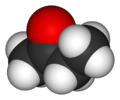 | |||
| |||
 | |||
| Names | |||
|---|---|---|---|
| Preferred IUPAC name Butan-2-one [2] | |||
Other names
| |||
| Identifiers | |||
3D model (JSmol) | |||
| 741880 | |||
| ChEBI | |||
| ChEMBL | |||
| ChemSpider | |||
| ECHA InfoCard | 100.001.054 | ||
| EC Number |
| ||
| 25656 | |||
| KEGG | |||
PubChem CID | |||
| RTECS number |
| ||
| UNII | |||
| UN number | 1193 | ||
CompTox Dashboard (EPA) | |||
| |||
| |||
| Properties | |||
| C4H8O | |||
| Molar mass | 72.107 g·mol−1 | ||
| Appearance | Colorless liquid | ||
| Odor | Mint or acetone-like [3] | ||
| Density | 0.8050 g/mL | ||
| Melting point | −86 °C (−123 °F; 187 K) | ||
| Boiling point | 79.64 °C (175.35 °F; 352.79 K) | ||
| 27.5 g/100 mL | |||
| log P | 0.37 [4] | ||
| Vapor pressure | 78 mmHg (20 °C) [3] | ||
| Acidity (pKa) | 14.7 | ||
| −45.58·10−6 cm3/mol | |||
Refractive index (nD) | 1.37880 | ||
| Viscosity | 0.43 cP | ||
| Structure | |||
| 2.76 D | |||
| Hazards | |||
| GHS labelling: | |||
  [5] [5] | |||
| Danger [5] | |||
| H225, H319, H336 [5] | |||
| P210, P233, P240, P241, P242, P243, P261, P264, P271, P280, P303+P361+P353, P304+P340, P305+P351+P338, P312, P337+P313, P370+P378, P403+P233, P403+P235, P405, P501 [5] | |||
| NFPA 704 (fire diamond) | |||
| Flash point | −9 °C (16 °F; 264 K) | ||
| 505 °C (941 °F; 778 K) | |||
| Explosive limits | 1.4–11.4% [3] | ||
| Lethal dose or concentration (LD, LC): | |||
LD50 (median dose) |
| ||
LC50 (median concentration) |
| ||
| NIOSH (US health exposure limits): | |||
PEL (Permissible) | TWA 200 ppm (590 mg/m3) [3] | ||
REL (Recommended) | TWA 200 ppm (590 mg/m3) ST 300 ppm (885 mg/m3) [3] | ||
IDLH (Immediate danger) | 3000 ppm [3] | ||
| Safety data sheet (SDS) | Safety Data Sheet | ||
| Related compounds | |||
Related ketones | |||
| Supplementary data page | |||
| Butanone (data page) | |||
Except where otherwise noted, data are given for materials in their standard state (at 25 °C [77 °F], 100 kPa). | |||
Butanone, also known as methyl ethyl ketone (MEK) or ethyl methyl ketone, [a] is an organic compound with the formula CH3C(O)CH2CH3. This colorless liquid ketone has a sharp, sweet odor reminiscent of acetone. It is produced industrially on a large scale, but occurs in nature only in trace amounts. [7] It is partially soluble in water, and is commonly used as an industrial solvent. [8] It is an isomer of another solvent, tetrahydrofuran.



